Abstract
In this article, comprehensive insights into the field of building maintenance, emphasizing the importance of keywords, collaborative efforts among authors, and the evolving research landscape, are provided. The use stage, as the longest phase in a building’s life cycle, involves economic, technical, and social activities. Numerous authors have contributed to the broader topic of building maintenance, covering aspects such as maintenance prioritization, improvement actions, decision-making guidelines, factors affecting success, cost estimation models, and BIM usage in maintenance. The study conducts a thorough literature review using Scopus as a search engine, employing the full-counting method for authorship, and uses VOSviewer 1.6.20 software for bibliometric analysis to identify gaps and outline future research directions. The results reveal distinct data sets focusing on building maintenance from general to specific, with each set reflecting unique aspects and considerations. Bibliometric maps illustrate author collaboration and keyword connections within each set, highlighting evolving research trends and areas of focus. Overall, the analysis highlights the importance of prioritizing maintenance, integrating technology, and fostering collaboration to enhance building maintenance in educational institutions. The study concludes with recommendations for future research, emphasizing the ongoing need for exploration and development in building maintenance, especially on maintenance strategies and Life Cycle Costs of university buildings.
1. Introduction
Life Cycle Cost management plays an important role that focuses on cost optimization [1], and this stage is the longest phase of a building’s life cycle [2,3,4]. It is a process which involves economic, technical, and social activities which should be organized in a reasonable way. In the use stage of a building, proper activities connected with the building operation as well as with building maintenance have to be properly planned. The whole building life cycle usage stage can be divided into seven sections: use, maintenance, repair, replacement, refurbishment, operational energy use, and operational water use.
Proper building maintenance ensures a reduction in CO2 emissions, an improvement in building energy efficiency, and a minimization of negative environmental impact, especially concerning older buildings constructed during a time when there were almost no thermal insulation regulations, in comparison to modern restrictions. However, building maintenance entails costs, particularly in the public sector, which are subjected to a lot of limitations and frequent inspections. To address these challenges, it is crucial to implement efficient maintenance strategies that balance environmental sustainability with budgetary constraints. According to [5], effective building maintenance plays a crucial role in reducing energy consumption and greenhouse gas emissions.
In the context of public utility buildings in Poland, such as those owned by public universities, the fundamental source of funding for renovations emanates from allocations within the state budget, primarily in the form of subsidies granted to universities based on appropriate algorithms. For a university to access funds for building maintenance under ministerial subsidies, it is mandated in Poland by the Law on Higher Education and Science [6] to formulate a financial plan. This plan, specified in Section 4, item 13, incorporates projected costs for building renovations. These projected costs for refurbishing university buildings are derived from renovation plans. Due to the limitations of the upgrade budgets, decision makers are always faced with a challenging task when identifying optimal sets of building upgrade measures [7].
A Life Cycle Cost analysis of maintenance costs and budgets for university buildings is essential [8]. Moreover, in order to ensure the provision of high-quality school facilities that foster healthy and conducive teaching and learning environments, the selection of appropriate building maintenance strategies is paramount. Research cited in [9] highlights the existence of subpar facility maintenance management practices within large public educational buildings. Since building maintenance is inseparably linked to building operation, it is worth mentioning an article [10] that presents a systematic literature review identifying potential triggers factors of the failure of activities in the field of sustainable operation of a university campus. To delve deeper into the role of facility management activities within educational settings, Kok et al. [11] provide insights into the functions of facilities. Many scientists have discussed the broad topic of building maintenance, focusing on, i.a., methods of maintenance prioritization [12], improvement actions in building maintenance management [13], the provision of guidelines on maintenance decision making [14], procedures and determination of factors affecting building maintenance success [15], and the implementation of extensive models for use in building maintenance processes like the multi-criteria decision-making model developed in [16], as well as on buildings’ maintenance cost estimation model assessment [17]. Moreover, Building Information Modeling (BIM) integration is increasingly used in building maintenance, and its role is expanding. BIM is highlighted as a supporting tool for Building Condition Assessment (BCA) and maintenance management, allowing for the permanent updating of building information [18]. Some of the publications highlight the importance of condition-based maintenance and the use of BIM to support decision making in building maintenance [19,20]. The integration of BIM together with deterioration models and three-dimensional facility models is suggested to manage the maintenance process efficiently in [21,22].
Moreover, facility management [FM], including maintenance, is acknowledged as challenging, often relying on paper records or information systems. However, traditional methods face limitations in integrating information effectively, hindering cooperation across various parties and disciplines [21].
This article aims to evaluate the approaches taken by authors in addressing the issue of university and educational building maintenance, particularly concerning additional regulations. It involves a comprehensive literature review focusing on specific keywords related to university buildings and maintenance practices. The objective is to identify research gaps in this area and outline potential future research directions. By analyzing existing studies, the article seeks to provide insights into the current state of knowledge regarding building maintenance in educational institutions, highlighting areas that require further investigation and suggesting paths for future research endeavors.
2. Materials and Methods
To comprehensively expand the literature review and gain deeper insights into prevailing trends in global scholarly research, bibliometric analysis software VOSviewer 1.6.20 [23] was utilized in conjunction with the Scopus database. The software facilitated the creation of bibliometric networks [24], enabling intricate network visualizations derived from carefully curated datasets. These visualizations allowed us to represent the complex web of connections and relationships within the vast body of literature explored. There are various types of bibliometric networks presented in the literature [25,26]. The literature analysis conducted was based on the full-counting method used by Gauffriau [7]. The method specifies each author of publications on an author’s publication list as 1, even if co-authors are involved. The further literature analysis drew upon a set of keywords linked to the central research problem, with specific constraints and parameters applied during the advanced search process within the Scopus database to ensure alignment with research objectives. It was recognized that the power of keyword selection lies not only in individual terms but also in their potential to synergize when paired or grouped with complementary keywords. Therefore, authors employed an approach to improve the literature search strategy by combining keywords to exploit interrelationships between them, thereby discovering articles related to our research interests. Network visualization introduced the concept of “clusters”, which emerge as groups of items sharing thematic or conceptual similarities. Each cluster was assigned a cluster number, simplifying the identification of thematic domains within the visualization. The study presents datasets sourced from the Scopus database focusing on global literature connected with educational building renovation and maintenance plans. The interpretation of selected datasets included co-authorship analysis, with specific criteria applied to ensure relevance and precision in the search process. The search was limited to specific fields, document types (such as articles, reviews, and conference papers), and subject areas, enabling a focused and comprehensive analysis of the research landscape. Another restriction targeted searches within the content of titles, abstracts, and keywords provided by authors.
The graphical representation—flow chart (Figure 1)—visually organizes the steps carried out by the authors while preparing the review.
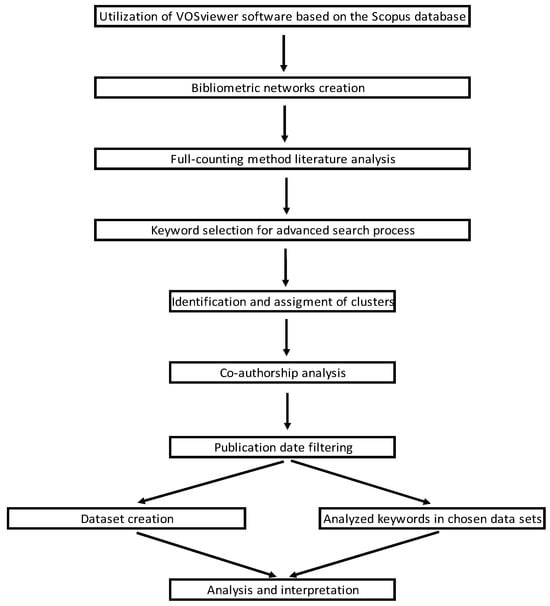
Figure 1.
Visual presentation of the research process.
To compile these data sets, specific limitations and keywords were applied for searches in the Scopus database, ensuring the relevance and precision of the collected literature (Table 1). The results are presented from the most general to specific ones, including articles published until February 2024. In the datasets created, an additional limitation of the document type was added, assigning documents as “article”, “review”, or “conference paper”.

Table 1.
Analyzed keywords in chosen data sets.
3. Results
3.1. Analysis of “Set 1”: “Maintenance”, “Strategy”, “Model”, “University Building”
The dataset denoted as “Set 1”, containing keywords such as “maintenance”, “strategy”, “model”, and “university building”, comprises contributions from six distinct author groups, collectively generating seven documents, encompassing articles, conference papers, and reviews. These groups created six clusters, each independently formed without interconnection, indicating diverse research trajectories (Figure 2). Nonetheless, the absence of interconnection does not preclude potential collaboration among authors. Notably, Sy-Jye Guo, affiliated with the College of Engineering at the National Taiwan University, features prominently in three clusters, indicating collaborative efforts with various researchers within the scope delineated by the “Set 1” keywords. All of the papers were published in the years 2008–2012, which could lead to the conclusion that the authors abandoned research work on this specific topic.

Figure 2.
“Set 1” bibliometric map.
Expanding beyond the limitations of “Set 1” Scopus data reveals that Guo S.J. has authored a total of 42 documents, of which 4 met the specified thresholds [8,27,28,29]. Among these, three are conference papers and one is an article. Notably, all documents address topics related to maintenance, life cycle cost analysis, and predictive methodologies in university buildings. Among the papers most closely aligned with civil engineering and the keyword searches, two stood out. Notably, one common co-author in both instances was Guo S. J., affiliated with the National Taiwan University. The first paper [8] represented a comprehensive case study. Using historical maintenance and repair data, the authors introduced various predictive models, including simple linear regression, multiple regression, and backpropagation artificial neural network (BP-ANN). Focusing on four university buildings situated in Taiwan, this study utilized predicted cost estimates based on building age, number of floors, and elevator count to inform budget allocations for maintenance and renovation endeavors. Significantly, the authors concluded that the BP-ANN model outperformed conventional linear and multiple regression models, highlighting its efficacy in cost prediction within the context of building maintenance planning.
The second noteworthy document entitled “Maintenance cost and budget for university buildings” [28], also affiliated with the National Taiwan University, emerged as a conference paper. It delved into maintenance and repair practices, amalgamating expert opinions with statistical quantification through Life Cycle Cost Analysis (LCCA). This comprehensive approach provided insights into the economic ramifications of maintenance decisions, offering a holistic perspective on infrastructure management.
Overall, researchers from Taiwan published four out of the seven articles featured in “Set 1” that met the predefined thresholds and research expectations. These articles principally focused on maintenance and LCCA pertinent to university buildings, aligning closely with the research objectives. Inversely, the remaining three papers diverged from the primary research theme. One explored students’ attitudes and behavioral intentions toward energy conservation [30], another investigated patterns of occupant density in light of the COVID-19 pandemic [31], and the last addressed image-based verification in photogrammetry to enhance facility management practices [32].
Following this, an examination of the keywords presented in “Set 1” publications was conducted. Given the modest size of “Set 1”, comprising seven papers, a minimum occurrence threshold was set—each keyword was required to appear at least twice. Out of 20 keywords, associations with the term “maintenance” were identified (keywords such as, among others, “maintenance cost and budget”, “maintenance strategies”, “maintenance cost”, “repair”, or “facilities management”). The visual representation of these associations is depicted in Figure 3, illustrating the interconnectedness within the maintenance cluster.
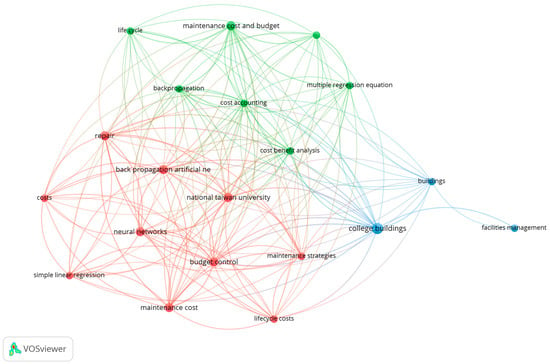
Figure 3.
Bibliometric map of “Set 1” keywords.
3.2. Analysis of “Set 2”: “Maintenance”, “Model”, “Cost”, “University Building”
“Set 2” diverges significantly from “Set 1”, as the keywords “maintenance”, “model”, “cost”, and “university building” were chosen based on the authors’ inclination towards these themes in their scientific work. Additionally, the inclusion of the words “model” and “cost” was motivated by the researchers’ willingness to check the scope of publications within this thematic spectrum.
The analyzed set comprises 22 groups of authors who collectively authored 23 documents, including articles, conference papers, and reviews (Figure 4). To meet predefined thresholds, these authors’ groups formed 22 distinct clusters, each operating independently of the others. However, the absence of interconnection between clusters does not preclude potential collaboration among authors within individual clusters.
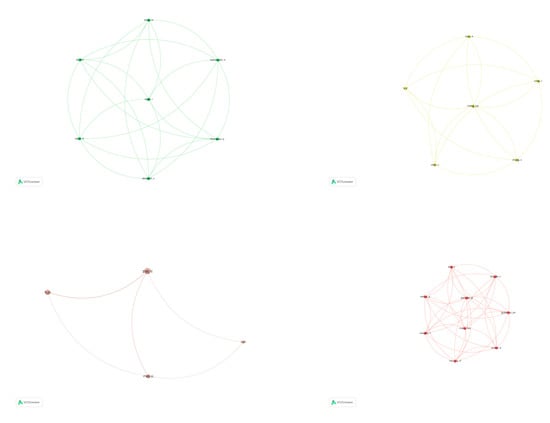
Figure 4.
“Set 2” bibliometric map—chosen connections.
Special attention is warranted for the presence of scientific papers authored by Sy-Jye Guo from the College of Engineering at the National Taiwan University, previously mentioned and described in “Set 1”, within the examined “Set 2”. Furthermore, the researchers identified a cluster consisting solely of their own contributions, named Plebankiewicz E. and Grącki J., which comprises a single scientific paper—an article published in 2023 [33]. In this paper, authors tried to predict future renovation costs in university buildings in Poland. The model was built based on historical renovation and repair cost data. A predictive model was created in two-phase research analysis. All in all, at the end the model utilized predicted renovation costs based on the building usable area and the period since the last major renovation, which was expressed in years. The model used the multiple regression method to calculate the predicted costs.
A cluster named Krstić H., Marenjak S. includes an article also closely connected with the researchers’ interests. The article, entitled “Maintenance and operation costs model for university buildings”, was published in 2017 and deals with the problem of the prediction of the maintenance costs of university buildings [34]. This paper presents a model designed to predict the average annual costs of maintenance and operations for university buildings in Osijek, Croatia, with similar characteristics. The model’s development and validation process utilized historical cost data spanning 12 years (1998–2010) from 13 university buildings in Osijek. Subsequently, the model underwent testing using data from two additional sets of buildings located outside of Osijek. By encapsulating key elements, the model provides a robust framework for estimating maintenance and operations costs, facilitating early-stage cost estimates during the design phase of university buildings. In this case, the regression model was used again, similar to previously mentioned scientific papers. The model predicts maintenance costs by identifying statistically significant variables such as the hallway area, office area, and overall surface area of each building.
“Set 2” consists of other scientific papers connected with the examined topic by keywords notwithstanding the specific search topic of the cost prediction of buildings using some mathematical models. However, a significant quantity of articles found in “Set 2” were connected with BIM use in university building maintenance from both the civil engineering point of view and that of the use of new technologies. Interesting was [35], where BIM 7D development framework was recommended in a case study. The use of the model can level up maintenance as well as sustainability and can fast-track the ability to use BIM models in a sustainable manner.
Another group of topics was a group connected largely with perceived sustainability and low emission. For instance, in the article [36], through BIM as well as Computational Fluid Dynamics software (https://openfoam.org/), research was carried out on the contribution of passive heating and cooling techniques to minimizing energy consumption in achieving the desired conditions of the interior’s thermal comfort.
All the publications were published in the years 1987–2023. The first one was titled “Life cycle cost of university buildings” [37], and the last one “A longitudinal controlled signage intervention to increase stair use at university buildings: Process and impact evaluation using RE-AIM framework” and was not connected with the searched topic branch.
Following this, an examination of the keywords presented in “Set 2” publications was conducted. Despite the bigger size of “Set 2” in comparison to “Set 1”, a minimum occurrence threshold remained unchanged—each keyword was required to appear at least twice. Out of the keywords found, associations with the term “maintenance” were identified (keywords such as, among others, “maintenance cost and budget”, “maintenance”, “maintenance cost”, “budget control”, or “life cycle”). The visual representation of these associations is depicted in Figure 5.
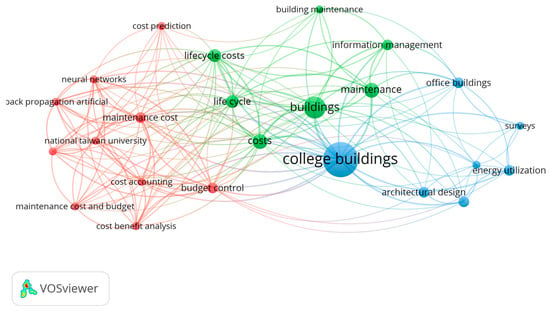
Figure 5.
Bibliometric map of “Set 2” keywords.
3.3. Analysis of “Set 3”: “Maintenance”, “Strategy”, “Educational Building”
The dataset denoted as “Set 3”, containing keywords such as “maintenance”, “strategy”, and “educational building”, comprises contributions from 15 distinct author groups, collectively generating 15 documents, encompassing articles, conference papers, and reviews. These groups created 15 clusters, each independently formed without interconnection, indicating diverse research trajectories (Figure 6). The visual representation of the keywords associated with “Set 3” publications is presented in Figure 7.
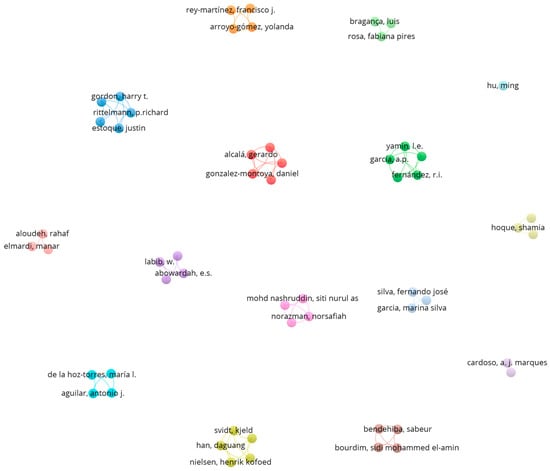
Figure 6.
“Set 3” bibliometric map.
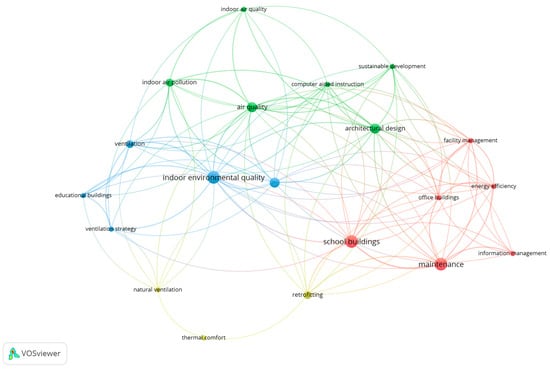
Figure 7.
Bibliometric map of “Set 3” keywords.
All of the papers were published in the years 1986–2024; however, before 2017, only two papers were published—a book from 1986 titled “Passive solar energy for non-residential buildings: performance overview”, which dealt more with the subject of building physics/passive houses and the reduction in energy consumption than with maintenance [38], and a second publication, published in 2006, which is a conference paper from the First World Congress on Engineering Asset Management. It is a paper in which the research work is strongly connected to the authors’ interest area, as it is strongly connected to educational buildings and maintenance costs [39]. In times of financial constraint, state budget allocations for the maintenance and operation of school buildings often face reductions, leading to the premature degradation of public-school infrastructure. This paper explores the impact of budget cuts on maintenance practices, particularly focusing on Portuguese secondary schools. Methodologically, the study involved collecting data through a questionnaire administered to 279 school administrations in 2004. The questionnaire addressed various aspects of maintenance management, including decision-making processes, human resources, information systems, and maintenance strategies. By analyzing the collected data, the authors identified areas requiring improvement and proposed recommendations to enhance maintenance management in educational buildings. The study underscores the importance of prioritizing maintenance, building systems, safety enhancements, and technology to improve the overall performance of educational institutions. Additionally, it emphasizes the role of maintenance audits in providing a systematic framework for evaluating and recommending performance enhancements.
Out of 15 documents, 9 met the “Engineering” subject area condition and 2 “Energy”, and 1 document was “Multidisciplinary”.
In the cluster Norazman N.; Salleh N.M.; Mohd Nashruddin S.N.A.; Wan Ismail W.N., the authors published an article entitled “Strategic planning of sustainable maintenance in heritage school buildings: Malaysia perspectives” [40]. The article discusses the importance of retrofitting and rehabilitation in the conservation of heritage buildings, particularly focusing on heritage schools in Malaysia. The authors emphasize the need for sustainable maintenance strategies due to the serious maintenance issues faced by these buildings, including, for instance, infrequent maintenance, repairs, or funding shortages.
Methodologically, the study relies on secondary data obtained from an intensive literature review, comparative studies from articles, and context analysis. The authors conducted a comparative study to identify typical issues with heritage school buildings and to determine the best maintenance practices for them. Additionally, they performed a SWOT analysis to evaluate the advantages and disadvantages of retrofitting and rehabilitating these buildings. The findings of the study aim to develop a strategic planning framework for the sustainable maintenance of heritage school buildings in Malaysia. The study also highlights best practices for sustainable maintenance and discusses the pros and cons of retrofitting and rehabilitation. The paper highlights the importance of strategic planning and sustainable maintenance for educational sector heritage buildings. What is worth articulating is the fact that this topic has not been extensively explored thus far.
The next article from the “Set 3” that is worth mentioning from the authors’ point of view is the article that comes from the cluster Kern A.P., Rosa F.P., Bragaca L., the title of which is “BIM-FM in existing buildings: a case study on educational and high-rise residential buildings” [41]. It explores the role of Facility Management in civil engineering, focusing on educational and high residential buildings. The study aims to analyze current facility management processes in these segments and propose a Facility Management—Building Information Modeling approach (BIM6D) to enhance the understanding of information flow and key stakeholders. Methodologically, the research employs a case study approach, drawing data from the FM processes of two buildings. The study unfolds in three stages: diagnosing FM practices, integrating FM with BIM, and analyzing information flow and key players. Maintenance activities are categorized and visualized using Revit design and Dynamo software (https://www.dynamosoftware.com/). The findings reveal disparities in FM practices, particularly in formalization and preventive measures, while highlighting common challenges such as information fragmentation and lack of control. FM-BIM integration improves information accessibility and optimizes the digital model’s use, particularly in the post-occupation phase. However, challenges arise in residential buildings lacking digital model expertise, suggesting a need for construction companies to play a more significant role. This study offers insights into BIM-FM integration in diverse contexts and underscores the importance of construction companies in the residential segment. It contributes real-life cases on BIM in existing buildings, discussing both the value and challenges of BIM in FM applications.
3.4. Analysis of “Set 4”: “Maintenance Strategy”, “Model”, “Building”
“Set 4” diverges from the other abovementioned sets; the keywords were chosen by the researchers as follows: “maintenance strategy”, “model”, and “building”. The keyword “maintenance model” as one keyword instead of two different keywords, “maintenance” and “strategy”, was chosen to find only publications where this phrase occurs collectively.
The examined set consisted of 672 authors’ groups that wrote 236 documents altogether—meaning articles, conference papers, and reviews here. The groups of authors which met the thresholds created 190 clusters (Figure 8). In the second phase, a threshold of the minimum number of documents for an author was set at the level of two documents. In this step, 46 out of 672 authors met the threshold, creating 23 clusters (Figure 9). This set was created to have a broader view on the topic analyzed, which is why not only university or educational buildings have been taken into consideration. However, it was very important to find the publications connected with maintenance strategies. Out of the wide range of publications, the authors chose 11 documents whose topics were connected to maintenance strategies of educational buildings. The documents were conference papers and articles and were published in the years 2015–2023 [18,19,20,21,22,42,43,44,45,46,47].
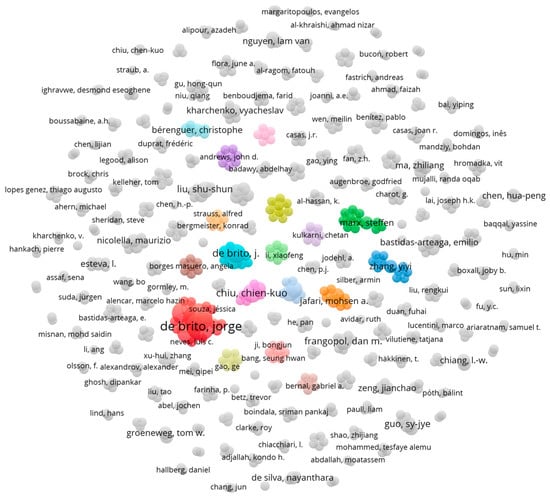
Figure 8.
“Set 4” bibliometric map—first phase (number of documents of an author—min. 1).
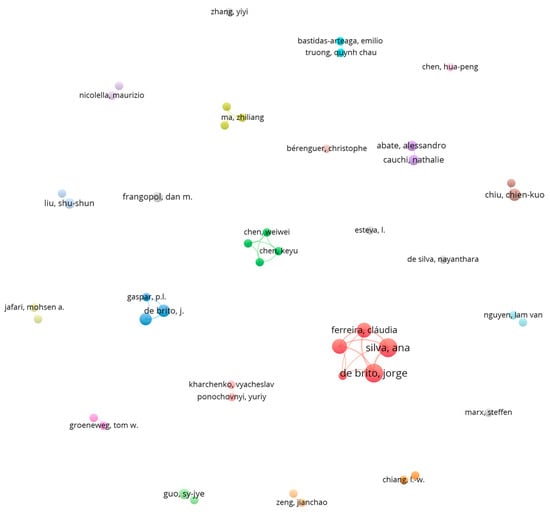
Figure 9.
“Set 4” bibliometric map—first phase (number of documents of an author—min. 2).
The first publication which is worth mentioning is a book entitled “The development of building maintenance management best practice in Malaysia: A review”, which was published in 2015 [42]. The authors present a schematic building maintenance value chain model and its implementation in Malaysian university buildings, highlighting improvements in building performance, cost reduction, sustainability, and user satisfaction. Methodologically, the authors draw on data from Malaysian university buildings to support their findings. They employ a combination of qualitative and quantitative analyses to assess the impact of the proposed maintenance management approach. The book is based on Malaysian data; nevertheless, its insights may be applicable to a broader area.
The next interesting publication is an article connected with the maintenance of high-rise buildings; like the previous one, it was published in Malaysia. The article, entitled “A case study of maintenance management systems in Malaysian complex and high-rise industrialized building system” [43], introduces a study conducted in Malaysia to address issues with maintenance management systems in complex and high-rise industrialized building systems. The research aimed to identify problem areas and establish elements of good practice by evaluating the performance of existing maintenance management systems and exploring the potential use of emerging technologies such as BIM. Methodologically, the study employed a case study approach involving eight industrialized building system building maintenance projects. Multiple case studies were conducted to explore variations in maintenance management issues, with interviews conducted with engineers responsible for maintenance management. The key findings revealed deficiencies in conventional maintenance methods, such as defect repetition and inadequate contractor competency. The implementation of emerging technologies, particularly BIM, was identified as a potential solution to improve maintenance management processes. The developed key feature of the maintenance management system included elements such as defect identification, assessment, and remedial measures, integrated with BIM technology. The study concludes that existing maintenance management systems are below best practice standards, highlighting the need for improvement. The use of emerging technologies like BIM can assist maintenance managers in effectively managing maintenance aspects and addressing major problems like defect repetition. Recommendations are made for organizations to adopt the new key features of the maintenance system to enhance their maintenance management practices.
What authors found also interesting was an article entitled “Maintenance management for public buildings using building information modeling BIM” [21], which shows the importance of maintenance in preserving buildings and equipment for normal use. It distinguishes between preventive maintenance, conducted regularly to prolong the lifespan of equipment, and corrective maintenance, carried out in response to emergencies or malfunctions. Despite perceptions of complexity and high costs, effective maintenance schedules contribute to longer building lifespans. The authors of the commented article propose employing BIM for maintenance management, which offers a visual representation of facility components, facilitating communication and information exchange among stakeholders. This approach enables the comprehensive integration of information, enhancing the visualization and understanding of maintenance requirements. The methodology involves a review of recent research on BIM’s applications in maintenance management, notably a study conducted at the University of Taiwan. This research aimed to improve maintenance management by leveraging BIM applications for tracking and sharing information. The use of BIM facilitated accurate geometric simulations, leading to cost and risk reduction in maintenance projects. BIM’s ability to preserve construction information digitally and provide a 3D environment enhances information accessibility during the maintenance phase, streamlining facility management processes.
The last article that the authors believe is worth mentioning is an article from 2021, which was written as a literature review and titled “Review on maintenance issues toward building maintenance management best practices” [45]. The article comprehensively reviewed building maintenance issues, once again in Malaysia, and proposed a conceptual framework based on best maintenance practices, utilizing the Plan-Do-Check-Act (PDCA) cycle and the ISO 14044 [48] guidelines. The methodology employed a systematic literature review to identify maintenance issues and recommendations for improvement. Five research databases were used for the literature search, generating 190 articles, which were narrowed down to 19 relevant ones. Data extraction and synthesis identified critical maintenance issues, such as financial constraints, planning and management inefficiencies, and technology-related challenges. The results highlighted the need for systematic management planning, staff development, and leveraging technology to enhance maintenance practices. The proposed framework emphasized financial control, planned maintenance, and clear maintenance policies to address these issues. The study concluded by recommending further case studies to evaluate maintenance efficiency based on ISO 14044 guidelines and the PDCA cycle.
All in all, the analysis of the keywords from “Set 4” publications was conducted. To limit the occurrence, out of the total number of 2325 keywords an additional threshold requiring a minimum of five occurrences per keyword was applied. This additional threshold gave 104 keywords meeting this criterion. Among the most frequently occurring keywords were “maintenance strategies”, “maintenance”, and “life cycle”. Notably, keywords such as “repair”, “service life”, and “condition-based maintenance” were also observed. A visual representation of the associations between these keywords can be found below, in Figure 10.

Figure 10.
Bibliometric map of “Set 4” keywords.
4. Conclusions
In summary, this study provided valuable insights into the research landscape within the field of building maintenance, emphasizing the significance of keywords, collaborative efforts among authors, and the dynamic evolution of research interests over time. The study depicts the literature review results based on the Scopus database. However, it should be stated that it is not a literature review of all publications from all over the world, because there are also other databases which may cover different ranges of articles. Despite this fact, the chosen database, in the authors’ opinion, is wide enough to allow the inference of conclusions.
The inception of publications addressing building maintenance strategy models can be traced back to the 1980s. Since the 2010s, there has been a noticeable increase in interest in this thematic area. Map interpretation revealed that maintenance is strongly connected to the following topics: decision making, life cycle, sustainable development, and cost optimization. Additionally, contemporary research within building maintenance, leveraging BIM tools, is notably focused on sustainability and climate change, and facility management can also be helpful in building maintenance. Summing up the literature review, proper building maintenance is not only essential from an economic point of view. It is also crucial to mitigate CO2 emissions, enhance energy efficiency, and reduce environmental impact.
Most publications connected to maintenance and university buildings were affiliated with universities from Taiwan, Malaysia, and other Asian countries (Figure 11). This topic is not really popular among European researchers; however, a publication from Portugal was also found. The collaborative efforts of researchers from the National Taiwan University have significantly enriched scholarly discourse, offering innovative solutions and invaluable insights into sustainable building maintenance and management practices. Such interdisciplinary endeavors exemplify the multifaceted nature of contemporary civil engineering research and underscore the importance of global collaboration in addressing complex challenges within the built environment.
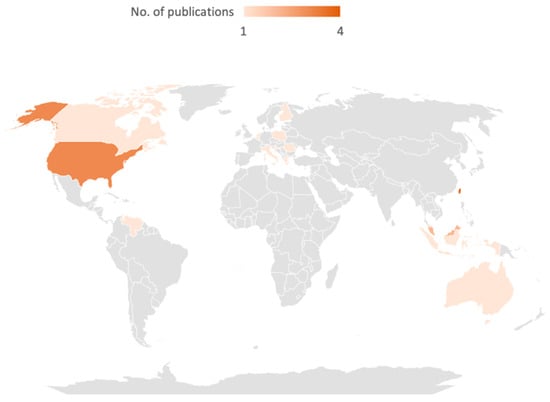
Figure 11.
Number of publications affiliated to specific countries—“Set 2”: “maintenance”, “model”, “cost”, “university building”.
Moreover, bibliometric networks reveal a trend in which researchers frequently do not delve deeper or expand upon previously explored topics. A majority of researchers contribute only a single publication and exhibit limited collaboration with researchers sharing similar interests in the field. The sheer volume of publications underscores substantial interest in the discussed topics, yet it also signals the existence of numerous aspects that warrant further exploration and development within this domain.
Furthermore, the study emphasizes the imperative for continued exploration in building maintenance, particularly in the context of higher education institutions. The authors of the article have already started work on building maintenance themes, especially within the realm of university buildings, with plans for further research focusing on maintenance strategies and Life Cycle Cost. The analysis results underscore the necessity, in future research, of paying particular attention to challenges in maintenance models correlated with LCC in public building facilities.
Author Contributions
Conceptualization, E.P.; methodology, E.P.; validation, J.G.; resources, J.G.; writing—original draft preparation, J.G.; writing—review and editing, E.P. All authors have read and agreed to the published version of the manuscript.
Funding
This research received no external funding.
Institutional Review Board Statement
Not applicable.
Informed Consent Statement
Not applicable.
Data Availability Statement
Data is contained within the article.
Conflicts of Interest
The authors declare no conflicts of interest.
References
- Hromádka, V.; Korytárová, J.; Vítková, E.; Seelmann, H.; Funk, T. New aspects of socioeconomic assessment of the railway infrastructure project life cycle. Appl. Sci. 2020, 10, 7355. [Google Scholar] [CrossRef]
- Vasishta, T.; Mehany, M.H.; Killingsworth, J. Comparative life cycle assesment (LCA) and life cycle cost analysis (LCCA) of precast and cast–in–place buildings in United States. J. Build. Eng. 2023, 67, 105921. [Google Scholar] [CrossRef]
- Ibn-Mohammed, T.; Greenough, R.; Taylor, S.; Ozawa-Meida, L.; Acquaye, A. Operational vs. embodied emissions in buildings—A review of current trends. Energy Build. 2013, 66, 232–245. [Google Scholar] [CrossRef]
- EN 15978:2011; Sustainability of Construction Works: Assessment of Environmental Performance of Buildings. European Committee for Standardization: Brussels, Belgium, 2011.
- Strielkowski, W.; Firsova, I.; Lukashenko, I.; Raudeliūnienė, J.; Tvaronavičienė, M. Effective Management of Energy Consumption during the COVID-19 Pandemic: The Role of ICT Solutions. Energies 2021, 14, 893. [Google Scholar] [CrossRef]
- Law on Higher Education and Science 20.07.2018 (Dz.U. 2018 poz. 1668). Available online: https://isap.sejm.gov.pl/isap.nsf/download.xsp/WDU20180001668/U/D20181668Lj.pdf (accessed on 20 January 2024).
- Gauffriau, M. Counting methods introduced into the bibliometric research literature 1970–2018: A review. Quant. Sci. Stud. 2021, 2, 932–975. [Google Scholar] [CrossRef]
- Li, C.-S.; Guo, S.-J. Life cycle cost analysis of maintenance costs and budgets for university buildings in Taiwan. J. Asian Archit. Build. Eng. 2012, 11, 87–94. [Google Scholar] [CrossRef]
- Lavy, S.; Bilbo, D.L. Facilities maintenance management practices in large public schools, Texas. Facilities 2009, 27, 5–20. [Google Scholar] [CrossRef]
- Amaral, A.R.; Gaspar, A.; Rodrigues, E.; Gomes, A. Lessons from unsuccessful energy and buildings sustainability actions in university campus operations. J. Clean. Prod. 2021, 297, 126665. [Google Scholar] [CrossRef]
- Kok, H.B.; Mobach, M.P.; Omta, O.S.W.F. The added value of facility management in the educational environment. J. Facil. Manag. 2011, 9, 249–265. [Google Scholar] [CrossRef]
- Cardinal, S.M.; Tosin, C.E.; Pilz, S.E.; Costella, M.F. Inspection Method for Building Maintenance Management in Higher Education Institutions. J. Perform. Constr. Facil. 2020, 34, 04020112. [Google Scholar] [CrossRef]
- Le, A.T.H.; Domingo, N.; Rasheed, E.; Parkl, K. Maturity model of building maintenance management for New Zealand’s state schools. Build. Res. Inf. 2021, 50, 438–451. [Google Scholar] [CrossRef]
- Chang, C.; Huang, S.; Guo, S. Setting a priority benchmark for building maintenance in Taiwan’s national universities. J. Arch. Plan. Res. 2008, 25, 162–175. [Google Scholar]
- Hauashdh, A.; Jailani, J.; Rahman, I.A.; AL-Fadhali, N. Structural equation model for assessing factors affecting building maintenance success. J. Build. Eng. 2021, 44, 102680. [Google Scholar] [CrossRef]
- Besiktepe, D.; Ozbek, M.E.; Atadero, R.A. Identification of the Criteria for Building Maintenance Decisions in Facility Management: First Step to Developing a Multi-Criteria Decision-Making Approach. Buildings 2020, 10, 166. [Google Scholar] [CrossRef]
- Plebankiewicz, E.; Leśniak, A.; Vitkova, E.; Hromadka, V. Models for estimating costs of public buildings maintaining—Review and assessment. Arch. Civ. Eng. 2022, 68, 335–351. [Google Scholar] [CrossRef]
- Matos, R.; Rodrigues, F.; Rodrigues, H.; Costa, A. Building condition assessment supported by Building Information Modelling. J. Build. Eng. 2021, 38, 102186. [Google Scholar] [CrossRef]
- Kameli, M.; Hosseinalipour, M.; Sardroud, J.M.; Ahmed, S.M.; Behruyan, M. Improving maintenance performance by developing an IFC BIM/RFID-based computer system. J. Ambient. Intell. Humaniz. Comput. 2021, 12, 3055–3074. [Google Scholar] [CrossRef]
- Omar, N.S.; Hatem, W.A.; Najy, H.I. Developing of building maintenance management by using bim. Int. J. Civ. Eng. Technol. 2018, 9, 1371–1383. [Google Scholar]
- Alhassan, B.; Omran, J.Y.; Jrad, F.A. Maintenance management for public buildings using building information modeling BIM. In Research Anthology on BIM and Digital Twins in Smart Cities; IGI Global: Hershey, PA, USA, 2022; pp. 487–503. [Google Scholar] [CrossRef]
- Gajzler, M. The Idea of Technical Predictive Maintenance of Utility Buildings Using Text Sources of Information About the Technical Condition of Buildings. Lect. Notes Netw. Syst. 2023, 709, 57–65. [Google Scholar] [CrossRef]
- Van Eck, N.J.; Waltman, L. Manual for VOSviewer Version 1.6.16, 25.11.2020; Universiteit Leiden: Leiden, The Netherlands, 2020. [Google Scholar]
- Perianes-Rodrigueza, A.; Waltmanb, L.; Van Eck, N.J. Constructing bibliometric networks: A comparison between full and fractional counting. J. Informetr. 2016, 10, 1178–1195. [Google Scholar] [CrossRef]
- Zhao, D.; Strotmann, A. Analysis and Visualization of Citation Networks; Morgan & Claypool Publishers: San Rafael, CA, USA, 2015. [Google Scholar]
- Van Eck, N.J.; Waltman, L. Visualizing bibliometric networks. In Measuring Scholarly Impact: Methods and Practice; Ding, Y., Rousseau, R., Wolfram, D., Eds.; Springer: Berlin/Heidelberg, Germany, 2014; pp. 285–320. [Google Scholar]
- Li, C.S.; Chen, P.J.; Guo, S.J. Application of back-propagation artificial neural network to predict maintenance costs and budget for University buildings. In Proceedings of the 2010 6th International Conference on Natural Computation, Yantai, China, 10–12 August 2010; Volume 3, pp. 1546–1551. [Google Scholar] [CrossRef]
- Li, C.H.; Chen, P.J.; Guo, S.J. Maintenance cost and budget for university buildings. In Proceedings of the EASEC-11—Eleventh East Asia-Pacific Conference on Structural Engineering and Construction, Taipei, China, 19–21 November 2008. [Google Scholar]
- Li, C.-S.; Guo, S.-J. Development of a cost predicting model for maintenance of university buildings. Adv. Intell. Soft Comput. 2012, 1, 215–221. [Google Scholar] [CrossRef] [PubMed]
- Franco, D.; Macke, J.; Cotton, D.; Paco, A.; Segers, J.-P.; Franco, L. Student energy-saving in higher education tackling the challenge of decarbonization. Int. J. Sustain. High. Educ. 2022, 23, 1648–1666. [Google Scholar] [CrossRef]
- D’Orazio, M.; Di Giuseppe, E.; Bernardini, G. Occupant density impact on building maintenance: Data-driven approach for university buildings. Autom. Constr. 2022, 141, 104451. [Google Scholar] [CrossRef]
- Klein, L.; Li, N.; Becerik-Gerber, B. Imaged-based verification of as-built documentation of operational buildings. Autom. Constr. 2012, 21, 161–171. [Google Scholar] [CrossRef]
- Plebankiewicz, E.; Grącki, J. Analysis and Prediction of Universities’ Buildings’ Renovation Costs Using a Regression Model. Appl. Sci. 2023, 13, 401. [Google Scholar] [CrossRef]
- Krstić, H.; Marenjak, S. Maintenance and operation costs model for university buildings. Tehnicki Vjesnik 2017, 24, 193–200. [Google Scholar] [CrossRef]
- McArthur, J.J. A Building Information Management (BIM) Framework and Supporting Case Study for Existing Building Operations, Maintenance and Sustainability. Procedia Eng. 2015, 118, 1104–1111. [Google Scholar] [CrossRef]
- Mytafides, C.K.; Dimoudi, A.; Zoras, S. Transformation of a university building into a zero energy building in Mediterranean climate. Energy Build. 2017, 155, 98–114. [Google Scholar] [CrossRef]
- Bromilow, F.J.; Pawsey, M.R. Life cycle cost of university buildings. Constr. Manag. Econ. 1987, 5, S3–S22. [Google Scholar] [CrossRef]
- Gordon, H.T.; Rittelmann, P.R.; Estoque, J.; Hart, G.K.; Kantrowitz, M. Passive Solar Energy For Non-Residential Buildings: Performance Overview. Adv. Sol. Energy 1986, 3, 171–206. [Google Scholar]
- Vieira, A.C.V.; Cardoso, A.J.M. Asset management characterization of the portuguese secondary school buildings. In Proceedings of the 1st World Congress on Engineering Asset Management, Gold Coast, Australia, 11–14 July 2006. [Google Scholar] [CrossRef]
- Norazman, N.; Salleh, N.M.; Mohd Nashruddin, S.N.A.; Wan Ismail, W.N. Strategic planning of sustainable maintenance in heritage school buildings: Malaysia perspectives. Int. J. Build. Pathol. Adapt. 2023. [Google Scholar] [CrossRef]
- Kern, A.P.; Rosa, F.P.; Bragança, L. BIM-FM in existing buildings: A case study on educational and high-rise residential buildings. J. Facil. Manag. 2022. [Google Scholar] [CrossRef]
- Nah, M.N.M.; Abdullah, S.; Razak, A.A. The development of building maintenance management best practice in Malaysia: A review. Adv. Environ. Biol. 2015, 9, 97–99. [Google Scholar]
- Ismail, Z.A.; Mutalib, A.A.; Hamzeh, N. A Case Study of Maintenance Management Systems in Malaysian Complex and High-rise Industrialized Building System Buildings. Int. J. Econ. Financ. Issues 2017, 6, 28–35. [Google Scholar] [CrossRef]
- Rocha, P.; Rodrigues, R.C. Bibliometric review of improvements in building maintenance. J. Qual. Maint. Eng. 2017, 23, 437–456. [Google Scholar] [CrossRef]
- Dzulkifli, N.; Sarbini, N.N.; Ibrahim, I.S.; Abidin, N.I.; Yahaya, F.M.; Azizan, N.Z.N. Review on maintenance issues toward building maintenance management best practices. J. Build. Eng. 2021, 44, 102985. [Google Scholar] [CrossRef]
- Margaritopoulos, E.; Xenidis, Y. Condition-based Maintenance Using BIM: A Case Study of Energy Modeling for a Residential Building. J. Eng. Proj. Prod. Manag. 2023, 13, 24. [Google Scholar] [CrossRef]
- Carvalho, A.T.; Calejo, R.; Santos, J. BIM Model as Support for Maintenance Activities. Lect. Notes Civ. Eng. 2024, 444, 53–62. [Google Scholar] [CrossRef]
- ISO 14044:2020/Amd 2:2020; Environmental Management—Life Cycle Assessment—Requirements and Guide-Lines—Amendment 2. International Organization for Standardization: Geneva, Switzerland, 2020.
Disclaimer/Publisher’s Note: The statements, opinions and data contained in all publications are solely those of the individual author(s) and contributor(s) and not of MDPI and/or the editor(s). MDPI and/or the editor(s) disclaim responsibility for any injury to people or property resulting from any ideas, methods, instructions or products referred to in the content. |
© 2024 by the authors. Licensee MDPI, Basel, Switzerland. This article is an open access article distributed under the terms and conditions of the Creative Commons Attribution (CC BY) license (https://creativecommons.org/licenses/by/4.0/).